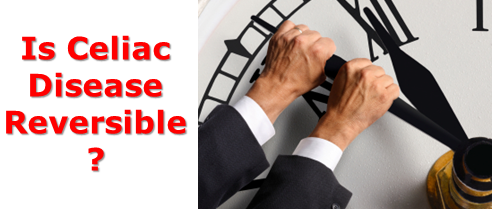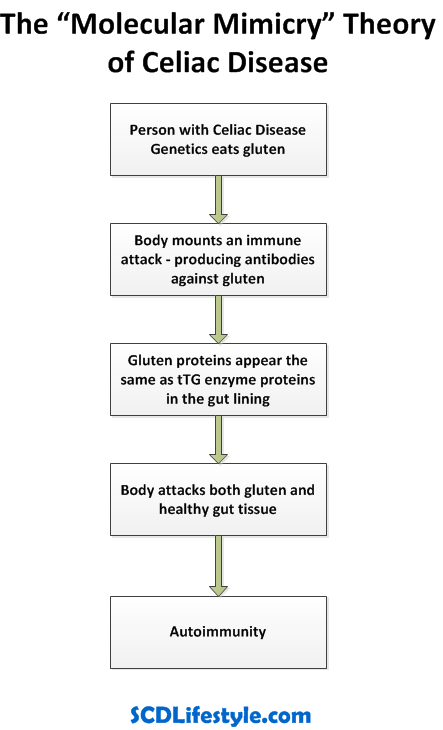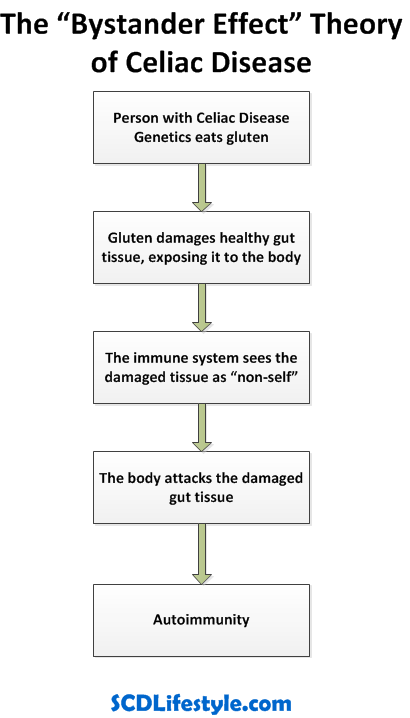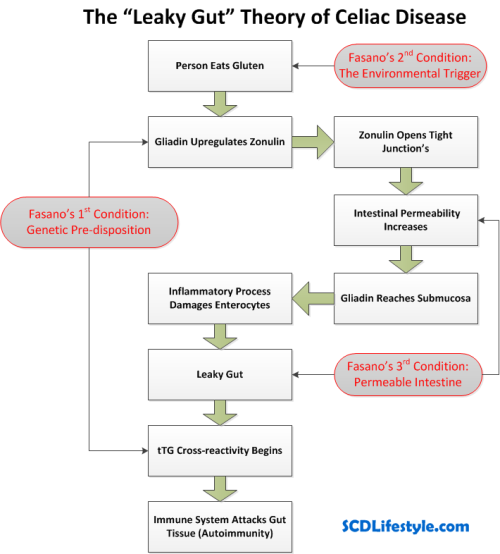Is Celiac Disease Reversible?

Until a few thousand years ago, we thought the world was flat.
Around 240 B.C., Eratosthenes broke new ground when he came up with an initial estimate of the Earth’s circumference… later supported in physical theory around 330 B.C. by Aristotle.
Since then, we’ve traveled to the moon and recorded beautiful footage of our round planet…
But there are still people that believe the world is flat (… Google “Flat Earth Society”).
As new ideas present themselves, we’re given the rare opportunity to grow into the next higher level of thinking. Medical research is a constantly evolving frontier and it’s our responsibility to take a step back to review our beliefs whenever new discoveries come to light.
Every evolution of medical research gives us a new lens to look at what we already know…
And Until Recently, We Thought Autoimmune Disease Wasn’t Reversible
We’re just beginning to understand why the immune system would attack healthy tissue… and in the beginning, we used to think that autoimmune diseases couldn’t be reversed once the immune condition “turned on.” (Big thanks to our show with Chris Kresser for helping me understand this in better detail.)
Here’s my crack at explaining how it relates to Celiac Disease…
Back when autoimmune conditions were first recognized over a hundred years ago, we thought it had everything to do with non-self antigens (like virus or bacterial infections). In fact, the condition was originally thought to be an infectious disease explained by the “Molecular Mimicry” theory, in which outside bacteria and viruses invade our body and look so similar to our own healthy tissue that the immune system wages war on both.[1]
It was thought to be the worst kind of mistaken identity…
The “Molecular Mimicry” theory goes something like this:
- A non-self antigen enters the body
- The immune system mounts an attack against it, producing antibodies
- The non-self antigen looks so similar to specific proteins in the body that it causes a cross-reaction to healthy tissue
- The immune system attacks the non-self antigen AND its own tissue from that point forward
It’s important to point out that in this model, even if the non-self antigen (bacteria or virus) triggering the attack is removed, the autoimmunity never turns off. So, the body continues to produce antibodies and attack healthy tissue even though the initial trigger is gone.
In the case of Celiac Disease, gluten is the non-self antigen and the “Molecular Mimicry” autoimmune process might look something like this:
Here’s what new research is revealing…
Molecular mimicry has been shown in animal autoimmune models to INITIATE the autoimmunity. In other words, it’s a part of the development of autoimmune disease in animals. However, recent human studies have shown that molecular mimicry is actually an EFFECT of human autoimmune disease, and not a cause of the autoimmunity.[2]
Why is that important?
It tells us that molecular mimicry is definitely a factor in the progression of pre-existing conditions that trigger autoimmune disease, but something else is responsible for triggering it in the first place.
In Celiac Disease, we know that gluten is a non-self antigen that finds its way inside the body and causes cross-reaction… but this evolution in thinking shows this to be only an effect of other pre-existing conditions.
So, What Else Could Be Confusing the Immune System?
Another theory suggests that non-self antigens come into our body and damage healthy tissues during active infection, exposing it to the immune system. The body sees these newly exposed areas as “non-self,” leading to the development of immune attacks against that tissue.
This mechanism usually goes by the name “Bystander Effect.” [3]
The “Bystander Effect” theory goes something like this:
- A non-self antigen enters the body
- The non-self antigen damages healthy tissue in the body
- The damage exposes parts of the healthy tissue that shouldn’t be exposed
- The body attacks the newly exposed areas as if they are not self
Again, with this model, even if the bacteria, virus, or gluten that damaged the tissue is removed, the autoimmunity never turns off. So, the body continues to produce antibodies and attack the exposed tissue even though the initial trigger that damaged it is gone.
In the case of Celiac Disease, gluten is the non-self antigen damaging healthy tissue and the “Bystander Effect” autoimmune process might look something like this:
New research into these theories isn’t making this any more clear. Both the “Bystander Effect” and “Molecular Mimicry” don’t explain the pre-existing conditions that lead to the autoimmune process…
But Both Theories Do Suggest Once Autoimmunity Turns on, There’s No Stopping It
However, the latest evolution in autoimmune research indicates there might be another way…
Researcher Alessio Fasano, M.D., has been on the forefront of recent autoimmune and Celiac Disease research. In 2011, he published a paper titled “Leaky Gut and Autoimmune Diseases” introducing a new theory that suggests prevention and reversal of autoimmune disease is possible.
He presents the idea that three pre-existing conditions must all exist together in order for autoimmune diseases to develop.[4] They are:
- A genetic predisposition to autoimmunity (In the case of Celiac Disease that’s the HLA DQ2/DQ8 genes)
- An exposure to the environmental trigger (in Celiac Disease – that’s gluten)
- Increased Intestinal Permeability (Leaky Gut)
Fasano’s theory is part of the new evolution of research implicating leaky gut as the key element to autoimmune disease. Applying Fasano’s “Leaky Gut” theory of autoimmunity to Celiac Disease boils down to this…
People with the genetics for Celiac Disease that have a leaky gut and eat gluten will develop autoimmunity and subsequent intestinal damage. The increased intestinal permeability allows the environmental trigger (gluten) to become exposed to the body and trigger the genetic predisposition.
Combined with what we learned in my last article in this series, it might look something like this:
Fasano’s new theory suggests that autoimmunity can be stopped and even reversed by removing the environmental/genetic trigger interaction and fixing leaky gut. This is groundbreaking in that it’s the first theory to present a pathway for autoimmune reversal…
But when I say autoimmune reversal, I don’t mean, “someone with Celiac Disease can eat gluten again.” To me, autoimmune reversal means that the tissues in the body go back to the way they were before the autoimmune process “turned on” in the first place, and normal health is restored.
So for Celiacs, that means the gut tissue heals, intestinal permeability is restored, and the finger-like villi become fully functioning again.
So, Removing Gluten Should Reverse Celiac Disease, Right?
The new research tells us this: if you have Celiac Disease, you have leaky gut. Even more explicit than that, you can’t develop Celiac Disease at all without having excessive permeability of the small intestine…
But what isn’t so clear is how the conventional Celiac Disease treatment plan fits into it…
According to this theory, here’s how a Gluten-Free Diet should help Celiac Disease:
- Remove 100% of gluten from the diet
- Zonulin levels decrease
- The Tight Junction’s restore normal function
- Leaky gut stops
- The autoimmune antibodies drop
- The autoimmune response shuts off
- Intestinal damage heals
But it Doesn’t Exactly Work that Way…
In the first post of this series, I pointed to new research suggesting the small intestines of up to 60% of adults never completely heal from Celiac Disease despite following a Gluten-Free Diet. [5] And another study found that only 8% of adult Celiac Disease patients eating a Gluten-Free Diet reached histological “normalization,” meaning their gut tissue completely recovered to that of a healthy person. [6]
So, what’s the missing piece of this equation?
Whether the latest evolution of research stands the test of time is irrelevant, what is relevant is that Fasano’s theory of autoimmunity opened the door to understanding where the Gluten-Free Diet fails to fully treat Celiac Disease and what needs to be resolved to reverse it.
In the next post of this series, I reveal which step of the process is broken and why the Gluten-Free Diet fails to reverse Celiac Disease.
Did You Like this Article?
Subscribe to our newsletter to receive email notifications, some ways to find relief, and next steps.



